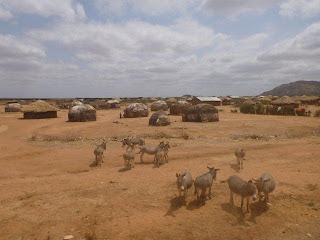We were spoilt in Lalibela. We stayed at a hotel for the first
time in ages and it was incredible. It’s the 28 day old Lalibela Lodge with sweeping
views of the entire mountainside, large rooms, hot showers, comfy beds and a
lovely owner, Hab.
They really are incredible constructions.
Eight of us only had one full day in Lalibela as we were heading
off overland to Axum and Debark (Simien Mountains) so we packed in a full day
of Lalibela’s famous rock-hewn churches.
Mario, Hab’s cousin, was our guide for the churches and he was
incredible. He grew up here and even used to play ‘hide and seek’ in the
churches and the myriad of secret underground tunnels so needless to say he
knows it well.
Scholars are divided on whether the churches are designed to
represent the powerful monarch’s reign, reproduce the holy site of Jerusalem or
communicate religious beliefs. Legend has it that the churches were hewn out of
the rock by angels but tradition speaks of 24 years of uninterrupted work day
and night by more than 40,000 people to complete these structures. Axes,
chisels, and hammers were amongst the primitive tools used to excavate the
churches, making it even more incredible, particularly as a high degree of
accuracy was required. King Lalibela had the inspiration in a vision and
devoted his entire life to their constructions, spending all his patrimony and
even selling off his children as slaves to gain the means to conclude his
mission! Since 1978 it has been on a World Heritage Site and it’s really no
wonder that it is supposedly the 8th wonder of the world.
The 1st group of churches contains: Biet Medhane Alem
(The Saviour of the World) – at 33.5m long by 23.5m wide by 11m high, it’s the
largest monolithic church in the world; Biet Mariam; Biet Maskal; Biet Denghel
(House of the Virgins); and Biet Golgotha-Micael-Selassie which includes the
Selassie crypt, the holiest place in Lalibela (which only men can get somewhat
nearer to but still cannot enter). ‘A Guide to Lalibela’ says the first
non-ecclesiastics known to have entered this chapel were Italians in 1939 and
this apparently took place ‘at the point of a pistol’.
Biet Giyorgis (St George) stands alone and it was by far my
favourite. Looking down from above on the cross-shaped church blew me away. It
had yellow lichen on the façade which is cleaned off at Ethiopian Christmas but
I think it adds to its charm. It has a secret access passage and three layers –
the bottom is meant to represent the water level of Noah’s Ark, the middle
where the animals were kept and the upper when Noah and his family lived.
The 2nd group of churches consists of: Biet Gabriel
Raphael; Biet Lehem (the holy bakery); Biet Mercurios (which has a pitch black
tunnel below it to represent hell and the church above represents heaven); Biet
Emmanuel; and Biet Abba Libanos.
They really are incredible constructions.
Of course we also had to sample Lalibela's local restaurants and bars albeit in the short time we had there.
Ben Abeba restaurant was recommended to us by a US architect we met in Ristorante Castelli in Addis
who has travelled around Ethiopia extensively. The restaurant was designed by two
young Ethiopians and has paths winding around each other skywards to a rooftop
with incredible views and a very cool owner, Suzie. The food is made fresh.
Unique
restaurant was then recommended to us by Suzie. It only has a couple of
tables but again, everything is made fresh.
Askalech/Torpedo
tej/Azmari bar was listed in the Lonely Planet. For 40 Birr we ordered the more
expensive ‘special’ tej (local honey wine) which is stronger and sweeter. The
tej comes out in a glass beaker and the waitress tips it on its side and taps
it against the tray to remove the thin layer of sediment on top.
The bar was a room
filled with people sitting on low tables and chairs, listening to local music.
A man was playing a one-stringed instrument with a bow, called a massinko and a
lady wearing a long, traditional white dress sung in accompaniment. They would
both pull people up from the crowd to dance with them – the ‘in’ style seems to
involve lots of shoulder jerking whilst keeping your hands still which, if you’re
uncoordinated, can feel like you’re doing the chicken dance! (much to the
amusement of the locals).
As if laughing at your dance style were not enough,
they also pick on people in the crowd (like a kind of court jester) and
evidently what they said was funny as everyone would roar out loud with
laughter. We couldn’t understand a thing as it was all in Amharic. As far as we
could gather from our taxi driver who came early to pick us up, they had a good
laugh at Shaun’s beard and also joked that although we were Australian they
still like us! (and something to do with us girls being sweet like candy!) I
think a lot was lost in the translation as clearly it was hilarious and all at
our expense.
Can’t wait to find another tej/Azmari bar but next time we will be
bringing an interpreter!

















































